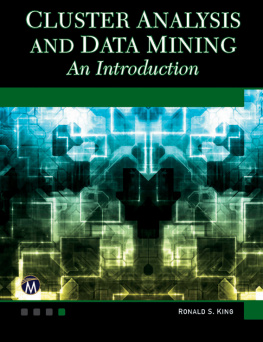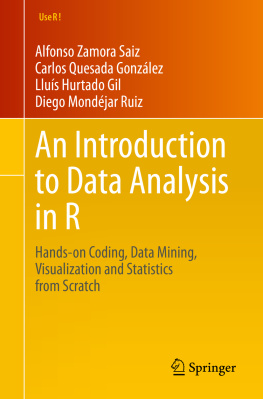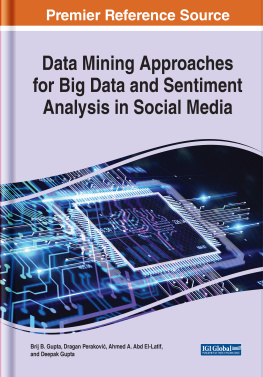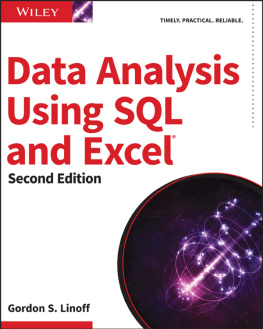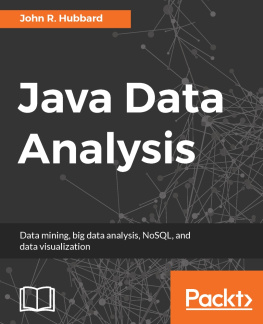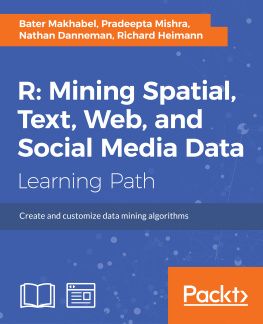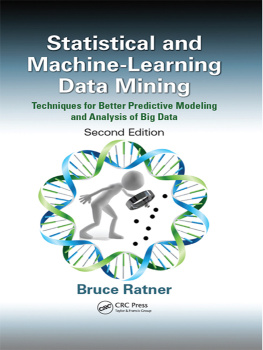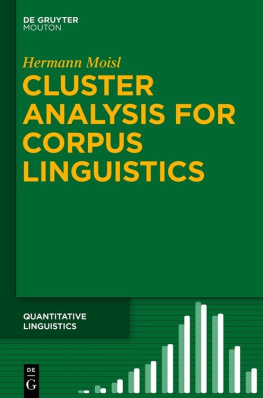R.S. King - Cluster Analysis and Data Mining: An Introduction
Here you can read online R.S. King - Cluster Analysis and Data Mining: An Introduction full text of the book (entire story) in english for free. Download pdf and epub, get meaning, cover and reviews about this ebook. year: 2014, publisher: Mercury Learning and Information, genre: Children. Description of the work, (preface) as well as reviews are available. Best literature library LitArk.com created for fans of good reading and offers a wide selection of genres:
Romance novel
Science fiction
Adventure
Detective
Science
History
Home and family
Prose
Art
Politics
Computer
Non-fiction
Religion
Business
Children
Humor
Choose a favorite category and find really read worthwhile books. Enjoy immersion in the world of imagination, feel the emotions of the characters or learn something new for yourself, make an fascinating discovery.
Cluster Analysis and Data Mining: An Introduction: summary, description and annotation
We offer to read an annotation, description, summary or preface (depends on what the author of the book "Cluster Analysis and Data Mining: An Introduction" wrote himself). If you haven't found the necessary information about the book — write in the comments, we will try to find it.
R.S. King: author's other books
Who wrote Cluster Analysis and Data Mining: An Introduction? Find out the surname, the name of the author of the book and a list of all author's works by series.
Cluster Analysis and Data Mining: An Introduction — read online for free the complete book (whole text) full work
Below is the text of the book, divided by pages. System saving the place of the last page read, allows you to conveniently read the book "Cluster Analysis and Data Mining: An Introduction" online for free, without having to search again every time where you left off. Put a bookmark, and you can go to the page where you finished reading at any time.
Font size:
Interval:
Bookmark:
AND DATA MINING
LICENSE, DISCLAIMER OF LIABILITY, AND LIMITED WARRANTY
By purchasing or using this book (the Work), you agree that this license grants permission to use the contents contained herein, but does not give you the right of ownership to any of the textual content in the book or ownership to any of the information or products contained in it. This license does not permit uploading of the Work onto the Internet or on a network (of any kind) without the written consent of the Publisher. Duplication or dissemination of any text, code, simulations, images, etc. contained herein is limited to and subject to licensing terms for the respective products, and permission must be obtained from the Publisher or the owner of the content, etc., in order to reproduce or network any portion of the textual material (in any media) that is contained in the Work.
M ERCURY L EARNING AND I NFORMATION (MLI or the Publisher) and anyone involved in the creation, writing, or production of the companion disc, accompanying algorithms, code, or computer programs (the software), and any accompanying Web site or software of the Work, cannot and do not warrant the performance or results that might be obtained by using the contents of the Work. The author, developers, and the Publisher have used their best efforts to insure the accuracy and functionality of the textual material and/or programs contained in this package; we, however, make no warranty of any kind, express or implied, regarding the performance of these contents or programs. The Work is sold as is without warranty (except for defective materials used in manufacturing the book or due to faulty workmanship).
The author, developers, and the publisher of any accompanying content, and anyone involved in the composition, production, and manufacturing of this work will not be liable for damages of any kind arising out of the use of (or the inability to use) the algorithms, source code, computer programs, or textual material contained in this publication. This includes, but is not limited to, loss of revenue or profit, or other incidental, physical, or consequential damages arising out of the use of this Work.
The sole remedy in the event of a claim of any kind is expressly limited to replacement of the book, and only at the discretion of the Publisher. The use of implied warranty and certain exclusions vary from state to state, and might not apply to the purchaser of this product.
AND DATA MINING
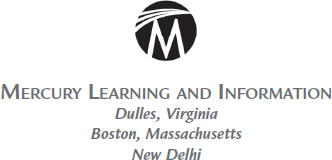
Copyright 2015 by M ERCURY L EARNING AND I NFORMATION LLC. All rights reserved.
This publication, portions of it, or any accompanying software may not be reproduced in any way, stored in a retrieval system of any type, or transmitted by any means, media, electronic display or mechanical display, including, but not limited to, photocopy, recording, Internet postings, or scanning, without prior permission in writing from the publisher.
Publisher: David Pallai
M ERCURY L EARNING AND I NFORMATION
22841 Quicksilver Drive
Dulles, VA 20166
www.merclearning.com
1-800-758-3756
This book is printed on acid-free paper.
R.S. King. Cluster Analysis and Data Mining: An Introduction
ISBN: 978-1-938549-38-0
The publisher recognizes and respects all marks used by companies, manufacturers, and developers as a means to distinguish their products. All brand names and product names mentioned in this book are trademarks or service marks of their respective companies. Any omission or misuse (of any kind) of service marks or trademarks, etc. is not an attempt to infringe on the property of others.
Library of Congress Control Number: 2014941165
141516321 Printed in the United States of America
Our titles are available for adoption, license, or bulk purchase by institutions, corporations, etc. Digital versions of this title are available at . For additional information, please contact the Customer Service Dept. at 1-800-758-3756 (toll free).
The sole obligation of M ERCURY L EARNING AND I NFORMATION to the purchaser is to replace the disc, based on defective materials or faulty workmanship, but not based on the operation or functionality of the product.
To the memory of my father, who made it possible and to LaJuan, the shining light in my life who survived the process.
On the DVD
Appendix A: Clustering Analysis with SPSS
Appendix B: Clustering Analysis with SAS
Appendix C: Neymann-Scott Cluster Generator Program Listing
Appendix D: Janceys Clustering Program Listing
Appendix E: JAN Program
Appendix F: UCI Machine Learning Depository KD Nuggets Data Sets
Appendix G: Free Statistics Software (Calculator)
Appendix H: Solutions to Odd Exercises
T his book is appropriate for a first course in clustering methods and data mining. Clustering and data mining methods are applicable in many fields of study, for example:
in the life sciences for developing complete taxonomies,
in the medical sciences for discovering more effective and economical means for making positive diagnosis in the treatment of patients,
in the behavioral and social sciences for discerning human judgments and behavior patterns,
in the earth sciences for identifying and classifying geographical regions,
in the engineering sciences for pattern recognition and artificial intelligence applications, and
in decision and information sciences for analysis of markets and documents.
The first five chapters consider early historical clustering methods. Chapters . JAN allows for numerical and categorical variables to be included in a clustering study.
All of the methods in Chapters , capture partitions plus modified versions for the partitions. The modified partitions allow for overlapping clusters.
is an introduction to the data mining topics of classification and association rules, which enable qualitative rather than simply quantitative data mining studies to be conducted.
Cluster analysis is essentially an art, but can be accomplished scientifically if the results of a clustering study can be validated. This is discussed in . Determination of the validity of individual clusters and the validation of a clustering, or collection of clusters, are discussed.
surveys a variety of algorithms for clustering categorical data: ROCK, STIRR, CACTUS, and CLICK. These methods are dependent on underlying data structures and are applicable to relational databases.
Applications of clustering methods are presented in Chapters is an overview of model-based clustering. This is often used in physical science research studies for data generation.
A summary of the issues and trends in the cluster analysis field is made in . Besides giving recommendations for further study, an introduction to neural networks is presented. The appendices provide a variety of resources (software, URLs, algorithms, references) for the cluster analysis plus URLs for test data files.
The text is applicable to either a course on clustering, data mining, and classification or as a companion text for a first class in applied statistics. Clustering and data mining are good motivators and applications of the topics commonly included in an introductory applied statistics course.
The scheduling references for each of the chapters, in an applied statistics class, could be as follows:
Font size:
Interval:
Bookmark:
Similar books «Cluster Analysis and Data Mining: An Introduction»
Look at similar books to Cluster Analysis and Data Mining: An Introduction. We have selected literature similar in name and meaning in the hope of providing readers with more options to find new, interesting, not yet read works.
Discussion, reviews of the book Cluster Analysis and Data Mining: An Introduction and just readers' own opinions. Leave your comments, write what you think about the work, its meaning or the main characters. Specify what exactly you liked and what you didn't like, and why you think so.

